#long hoverfly
Text
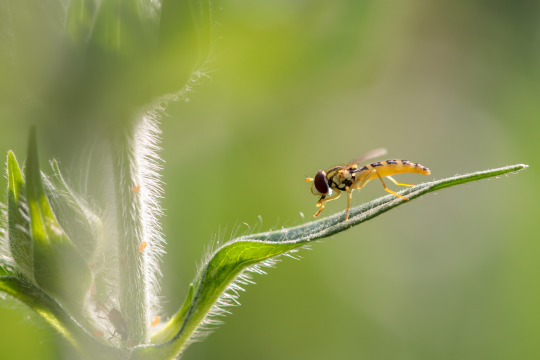
Long Hoverfly
A long hoverfly resting on a sunlit leaf, in the garden.
#30dayswild#canon#canonuk#fauna#garden#hoverflies#hoverfly#insect#insects#invertebrate#invertebrates#long hoverfly#minibeast#minibeasts#nature#outdoors#sphaerophoria scripta#spring#springwatch#wildlife
14 notes
·
View notes
Text
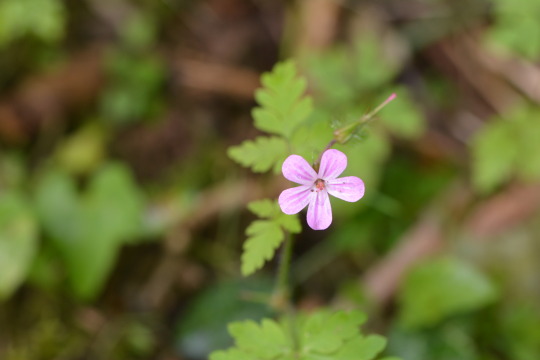


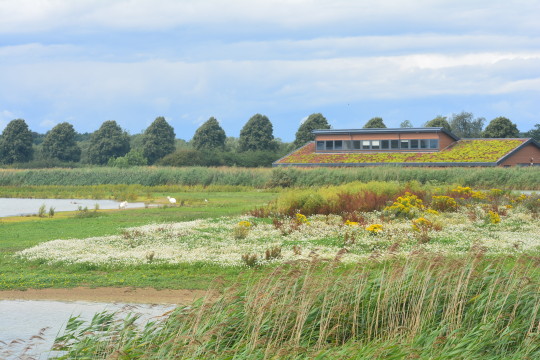
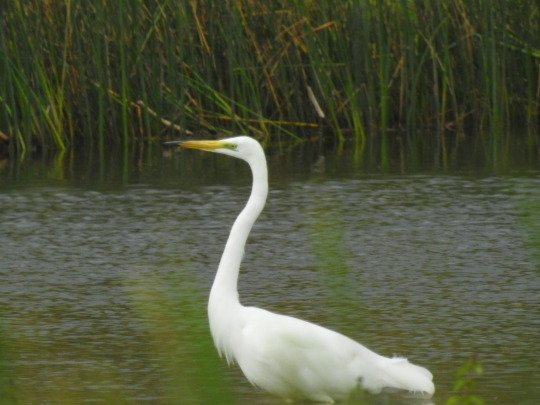

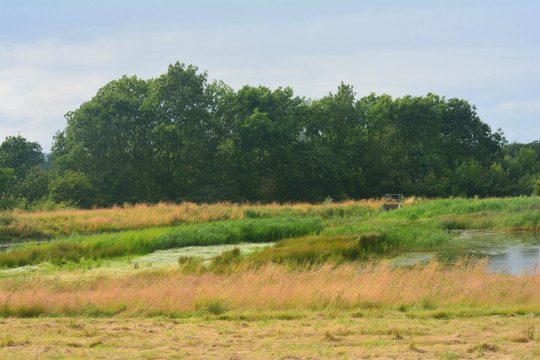



16th July 2023: Egleton, Rutland Water
Photos taken in this set: 1. Herb-Robert. 2, 3, 4, 6 and 7. Views at this beautiful reserve. 5. Great White Egret, a star bird again this weekend. I still find it quite surreal when we have a run of visiting good habitats for them and they're so commonplace, being a bird that was a real rarity when I first got into birdwatching. They're great to watch too with their larger than life stature and quirky movements. 8. Green Sandpiper, a key bird that we wanted to see at the nature reserves whilst away and it was an honour to see loads of them on lagaoon four. They are such beautiful birds and I really just enjoyed watching them and taking them in. 9. Comma, one of a few wonderful butterflies I enjoyed seeing especially in a blooming patch of meadow. 10. Egyptian Geese, another key Rutland bird, with adorable goslings. The gosling I saw of one at Petersfield Heath Pond earlier in the month was the first Egyptian gosling I'd seen I think but was bigger so it was lovely seeing these little goslings.
Another year tick in Yellow-legged Gull seen nicely with Herring and Lesser Black-backed Gulls for comparison and some chicks of the latter in an Osprey nesting platform were other key birds seen, as well as stunning views of Osprey and Hobby acrobatically working through the air seeing both successfully hunt. Birds I adore seen so well this weekend. Sand Martin, Little Egret, Great Crested and Little Grebe, Shelduck, Blackcap seen extremely well, Reed Warbler, delightful Teal, Gadwall, Lapwing, Oystercatcher, Common Sandpiper, Common Tern, Swift, Goldfinch, Pied Wagtail and Linnet chasing each other and Stock Dove were other key birds seen. It was an insect fest with Painted Lady, Red Admirals, Gatekeeper, Ringlet, Meadow Brown, Brimstone, Small Tortoiseshell seen well at the visitor centre, Small Skipper, Green-veined White, Small White and Speckled Wood butterflies, Southern Hawker, Common Darter, Brown Hawker and Black-tailed Skimmer dragonflies, Common Red Soldier beetle, ladybird, Bird-cherry Ermine moth and Marmalade and Long hoverflies other standout insects seen. Poppy, fox-and-cubs, bird vetch, wild carrot, lady's bedstraw, field scabious, self-heal, viper's-bugloss, red campion, white deadnettle, white and broad-leaved clover, thistle, great willowherb, ragwort, forget-me-not, burdock and meadowsweet were other key plants seen.
#meadowsweet#photography#birdwatching#lady's bedstraw#painted lady#yellow-legged gull#green sandpiper#white deadnettle#england#uk#world#nature#viper's-bugloss#marmalade hoverfly#long hoverfly#small skipper#bird-cherry ermine moth#happy#photos#osprey#hobby#lesser black-backed gull#2023#egleton#great white egret#egyptian goose#rutland water#rutland#europe#walking
6 notes
·
View notes
Text
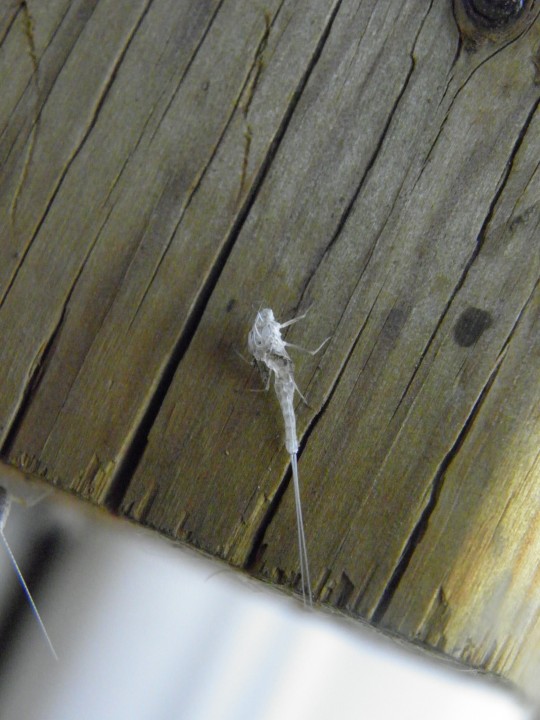




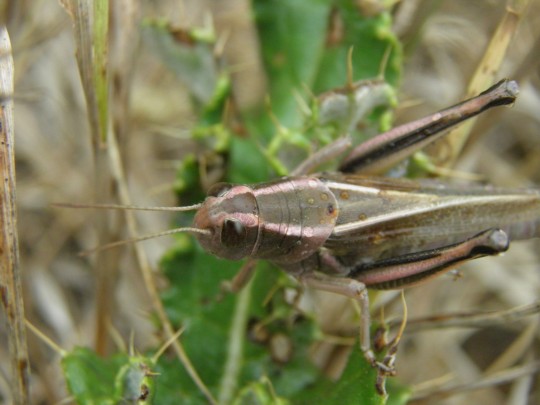

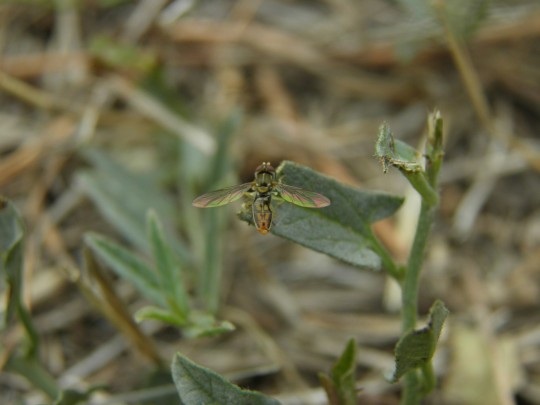
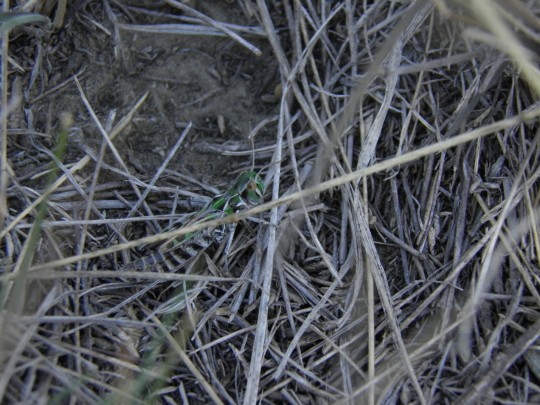
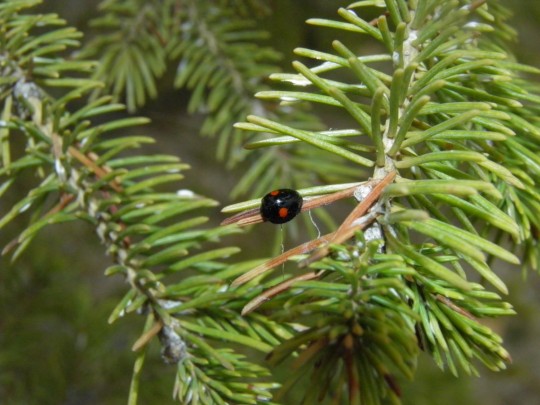
@gallifreyanconsultingphilosopher submitted: Some photos from summer! My favourites are the ichneumon wasp (#3), the grasshopper with slight erythism (#6), the green grasshopper, and the twice-stabbed lady beetle! Also the syrphid fly's got a dented abdomen, the silly fella.
From southern Alberta, save for the green grasshopper who's in southern Saskatchewan. Do you have any idea what the ID of the wasp in #7 is? I think it's another ichneumon but I'm wondering if it has a specific name.
They are all beautiful! I'm especially in love with the very pretty iridescence on the wings of the hoverfly, and the lovely bit of erythritic pink on the first grasshopper that you mentioned.
The fella in the 7th photo looks like a horntail rather than a wasp to me. They're related to wasps, though. Pretty sure it's a male since it's got the thickened hind legs and no ovipositor that I can see. I can't tell which species, though.
#animals#insects#bugs#submission#mayfly#molt#exuvia#wasp#ichneumon wasp#beetle#weevil#butterfly#grasshopper#erythrism#horntail#hoverfly#twice stabbed lady beetle#long post
60 notes
·
View notes
Text



7/29/2023
Mount Rainer
1. Long horned Beetle (evodinus monticola)
2. Bee mimicking flower fly (sericomyis chalcopyga)
3. Gossamer-winged butterfly - Boisduval's Blue (plebejus icarioides)
#mine#insects#flowers#mountain flowers#hoverfly#flower flies#beetles#pnw#pnw insects#Mount Rainier#purple#yellow#green#long horned beetle#gossamer winged butterfly#boisduvals blue#photography
3 notes
·
View notes
Text
I see at least one cool bug a day, and usually many more, but it’s not because I live anywhere particularly rich in strange, wonderful creatures (I live in an unremarkable corner of Pennsylvania, USA) or spend all of my free time looking for bugs (well, just *most* of it). in my experience, finding interesting bugs is less about actually locating them and more about looking closely at tiny things you’d otherwise ignore!
this very long post was compiled over a couple days in late July, although I spent less than 10 minutes at a time searching. there’s a lot of fun creatures just out in the open.

plants are always a good place to start when looking for bugs, and I chose this small fig tree (Ficus carica) with a mulberry sapling friend. feeding on the sap of the fig and mulberry is the first group I’ll take a look at, the planthoppers:

these two are flatid bugs, Metcalfa pruinosa and Flatormenis proxima. flatids are slow-moving bugs that can be approached closely, but once they get tired of circling around stems to avoid you they may launch themselves into a fluttering flight with spring-loaded rear legs.
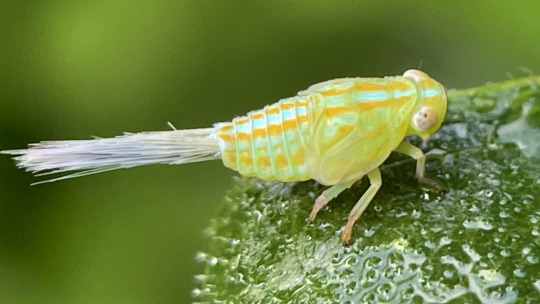
Aplos simplex, a member of the related family Issidae, also likes fig sap. its “tail” is actually a tuft of waxy secretions, which get shed along with the bright colors when it assumes a lumpy, bean-shaped adult form.
cicadellids, or leafhoppers, are just about everywhere on plants, but can be hard to approach without scaring them.


Agallia constricta on the left is a tiny species that feeds on grass, but many were scared up onto the fig by my footsteps. Jikradia olitoria is a much larger species that does feed on the fig; juveniles like this are curled, creeping goblins while adults’ rounded wings give them a pill-shaped appearance.

this big, pale leafhopper belongs to genus Gyponana. it’s tricky to get to species ID with these.
Graphocephala are striking little hoppers that eat a variety of native and nonnative plants. G. coccinea is the larger, more boldly colored one and G. versuta is smaller but more common locally. they’ll sit on the tops of leaves but take flight if you get too close quickly.
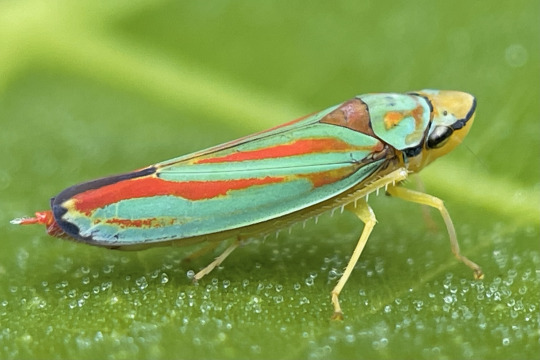
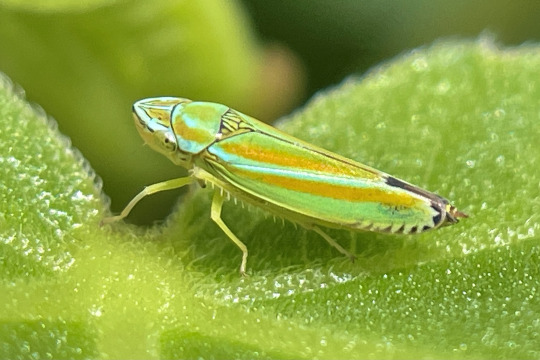
another group you’re almost guaranteed to encounter are flies (Diptera). these are a very diverse group, so much more than houseflies and mosquitoes (though I did run into both)
where I live, any plant with broad leaves is almost guaranteed to have a few Condylostylus, long-legged flies that come in shades of blue, green, and red. despite their dainty physique, they’re agile predators, typically feeding on other small flies.
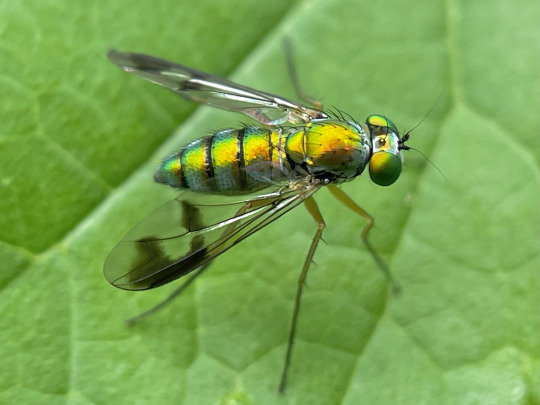
next, a few hoverflies: the ubiquitous Toxomerus geminatus and a Eumerus that I’ve been seeing a lot of this year (but maybe I’ve just noticed them for the first time). syrphids have varied life histories, but most adults drink nectar and many of the larvae are predaceous on aphids.
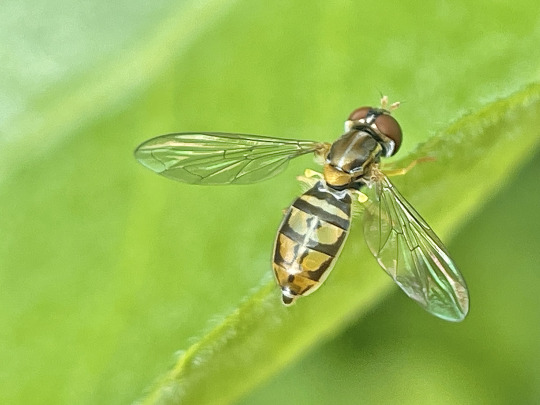
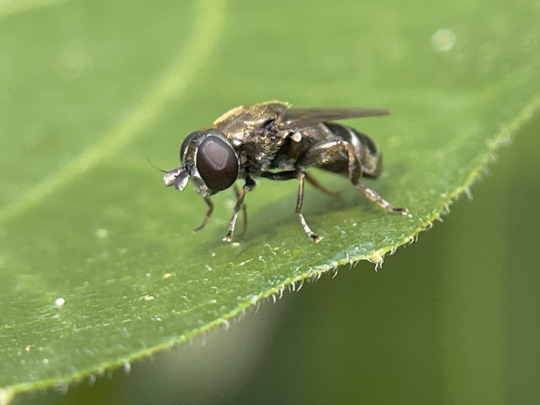
the metallic green soldier fly is Microchrysa flaviventris, nonnative here. Coenosia is a fun example of a “fly that looks like a fly,” with big red eyes and a gray body, and you might think they’re just another dung-sucking pest, but they’re actually aggressive predators! this one seemed to have nabbed itself some sort of nematoceran fly, maybe a fungus gnat.
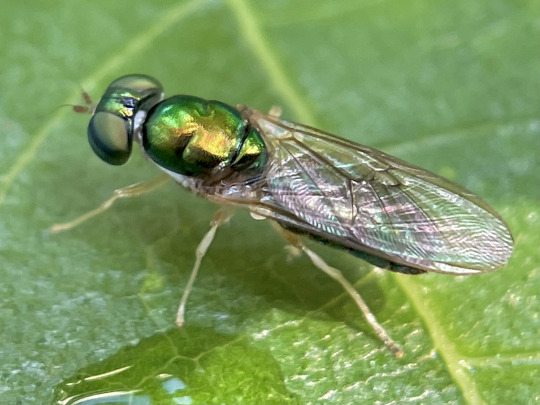

many flies are very tiny, just millimeters long. the first two little fellows are lauxaniids, while the last one, an agromyzid leafminer Cerodontha dorsalis, burrows through grass leaves as a larva.
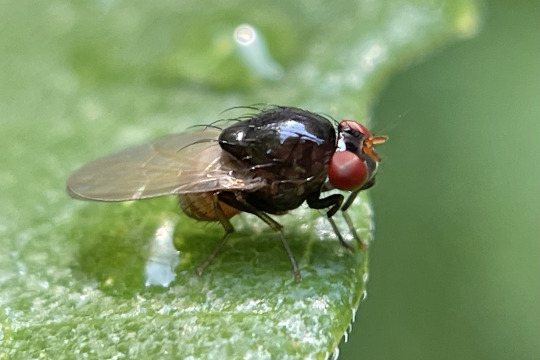
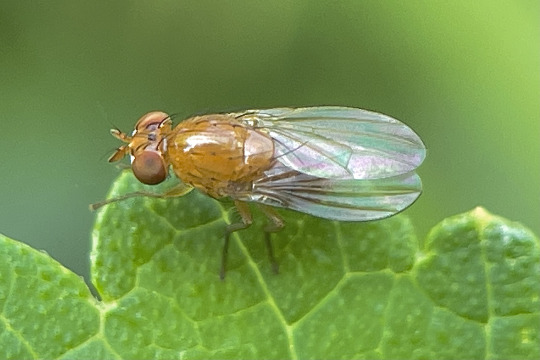

while moths and butterflies (Lepidoptera) are drawn to plants for their flowers or to lay eggs, many small moths can easily be found resting on or under leaves during the day.
these first two are tortricids, many of which are flat, rectangular moths resembling chips of bark or dead leaves. the apple bud moth, Platynota idaeusalis, feeds on a wide variety of hosts, while this beat-up old Argyrotaenia pinatubana would have developed in an edible tube nest of pine needles.


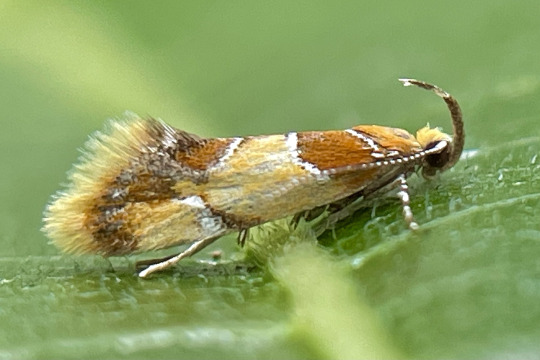
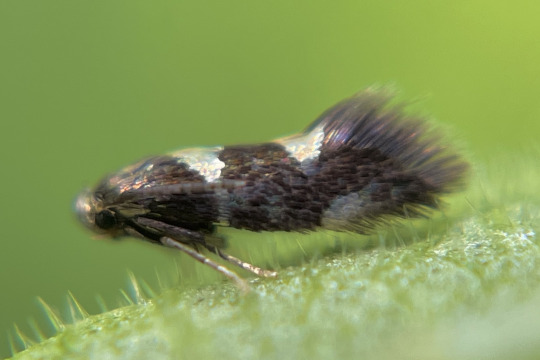
Callima argenticinctella feeds in bark and dead wood (a resource used by more caterpillars than you’d realize!) while the last moth, possibly an Aspilanta, is a leafminer.
although beetles (Coleoptera) are famous for their diversity, I didn’t find too many on the fig. the invasive Oriental beetle Exomala orientalis resting here can be found in a wide range of colors, from this common tan to to deep iridescent black. the other beetle is a Photinus pyralis firefly, sleeping under leaves as fireflies do.
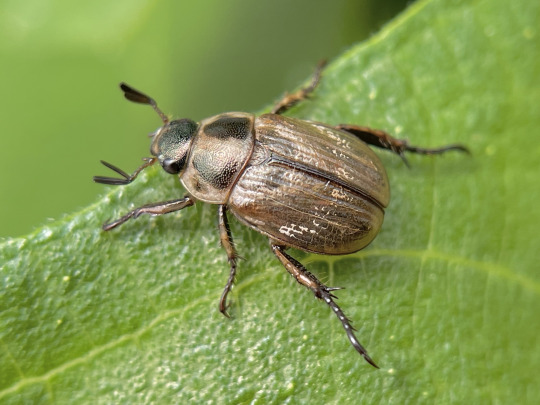

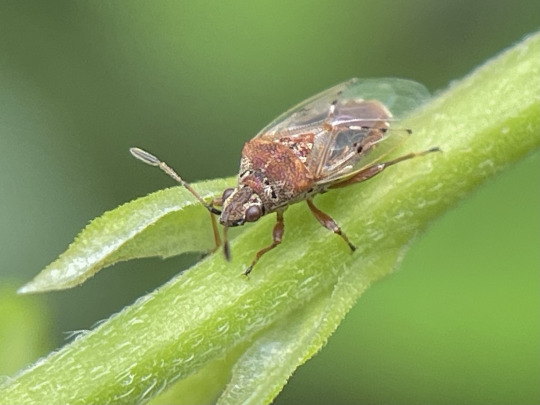
a few spare hemipterans: a Kleidocerys resedae that blew in on a wind, and below, the mulberry whitefly Tetraleurodes mori feeds on its namesake host. as for Hymenoptera, I saw manny tiny parasitic braconid wasps and various ants attracted to the planthoppers’ honeydew excretions—always worth checking underneath roosting hoppers for things having a drink.

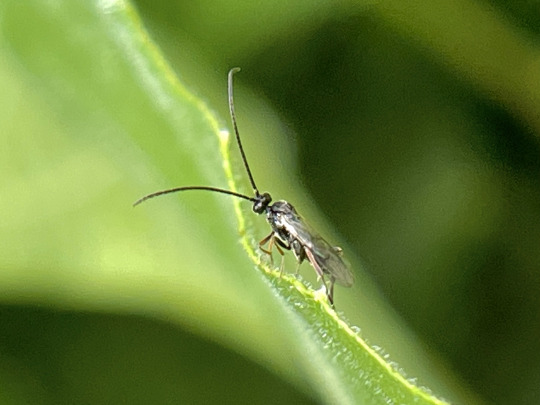
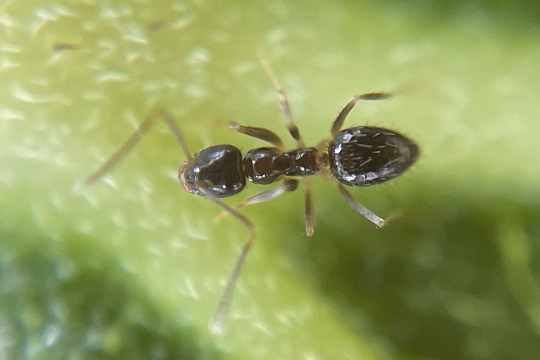
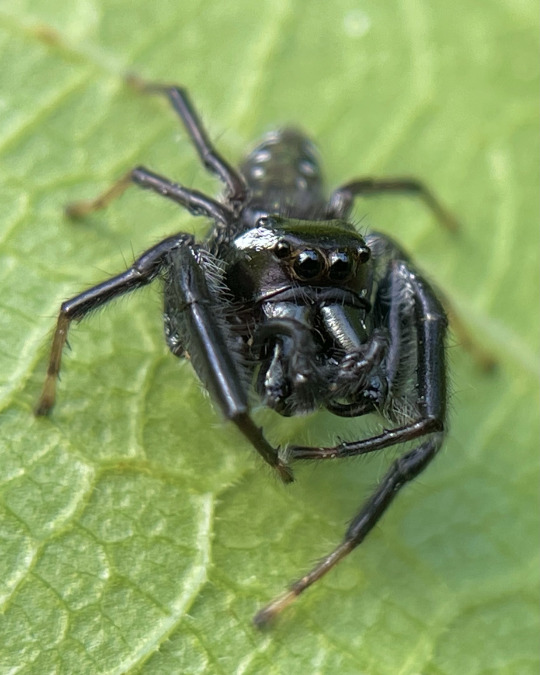
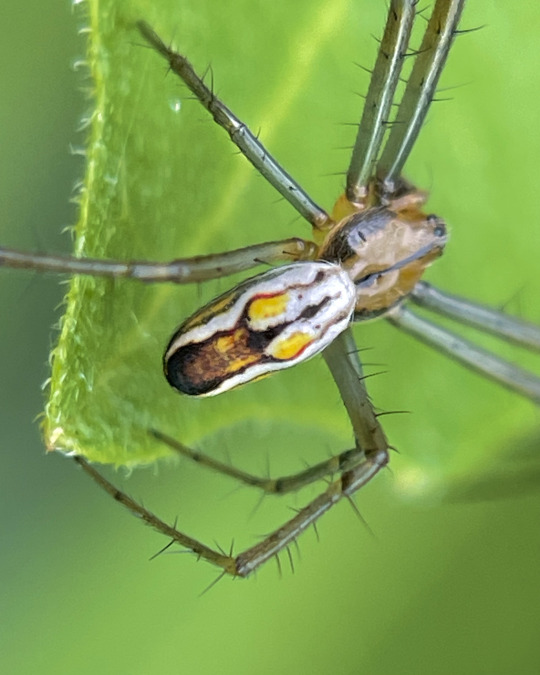
a couple handsome spider boys were scrambling through the fig seeking females, a jumping spider Paraphidippus aurantius and an orbweaver, Mecynogea lemniscata.
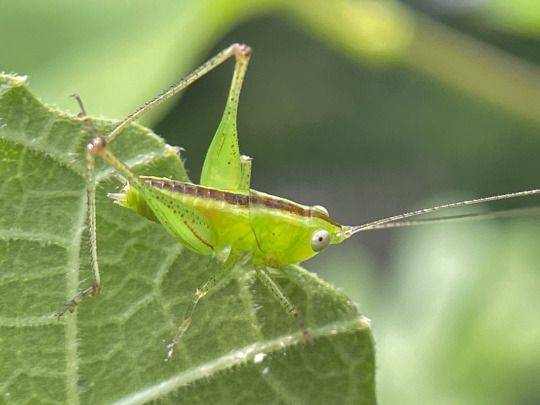
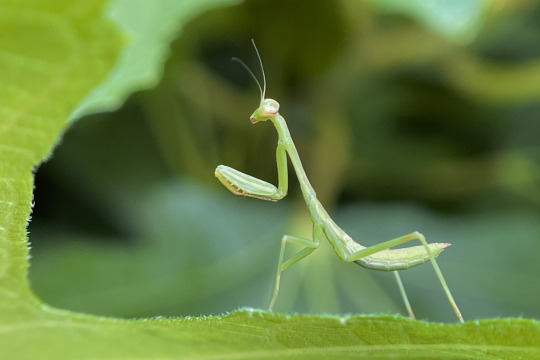
and to round it off, a young Conocephalus meadow katydid and a Carolina mantis, Stagmomantis carolina.
there’s 31 species of arthropod in this post, and I probably saw some 45, not all of which stayed for photos. if you walk slowly and look closely, you can see a sizeable chunk of your local biodiversity in under fifteen minutes! of course this will depend on where you live and what time of year it is, but there’s almost always more cool bugs out there than you’d expect, even on just a single plant.
1K notes
·
View notes
Text
i miss bugs so bad. its mid april and there's hardly been a buzz in the air. how long has it been since ive seen a ladybug hobbling on a blade of grass. what about butterflies dancing from flower to flower or hoverflies zipping from bud to bud. my lights are on at night and yet my windows are noticably unharrassed by moths & other nightly bugs. where are millipedes. where are pondskaters. where are the spiders suspended on the sideview mirrors of cars. hell, even regular old flies. bees. wasps. ants. i see so few of them now. this is such a weird thing to see happen in my lifetime. i really miss just seeing bugs around.
#i know this has already been talked about but i still can't believe how prevalent it is#im sure the fact ive moved closer to the city contributes#i grew up in a small town#but even when i go home to visit#nothing#its so quiet#i still see slugs and snails#when it rains#i suppose#they seem to be doing alright#bugblr#bugs#insects#.txt
22 notes
·
View notes
Text
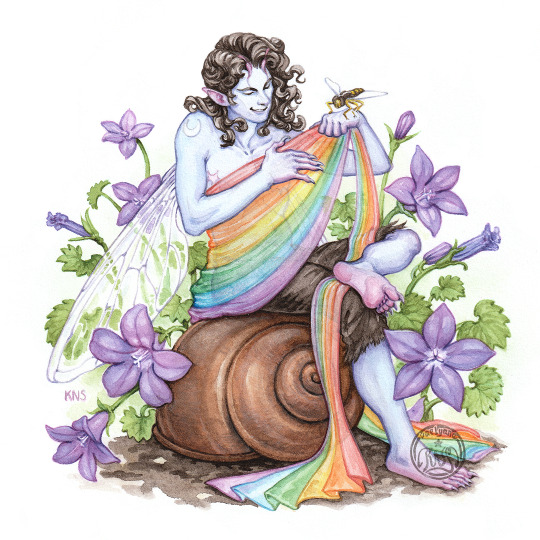

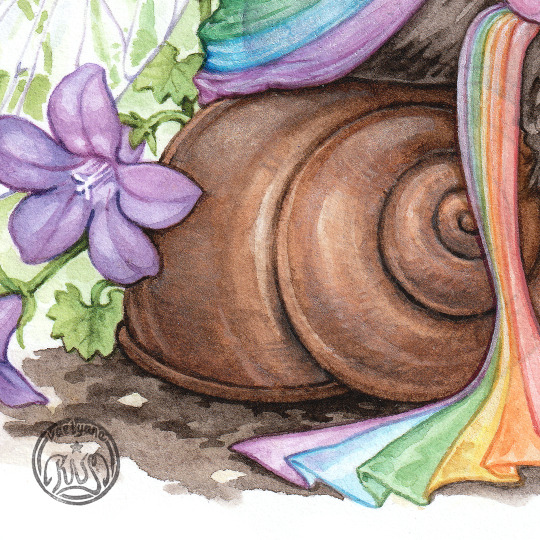
🇬🇧 Hello there, and Happy Pride month! :D I hope you're not melting too much. 🫠 My watercolour piece for this year is a trans faerie, trying on a long rainbow cloth amidst the bellflowers in my garden. I hope you'll like him and his pet hoverfly! 🧚♂️🏳️🌈
I wouldn't recommend painting a transparent Pride flag with watercolours unless you're extremely well prepared! As it turns out, I was not. Imagine me screaming and crying internally while covering my sins with white acrylic gouache. 😂
On a slightly more serious note, it hasn't been an easy year for LGBTQ+ people. If you're queer in any way, I want you to feel safe and welcome here. You matter more than you know. Take care! 💖
~~~~~~~~~~
🇫🇷 Bonjour, et Joyeux Mois des Fiertés ! :D J'espère que vous n'êtes pas trop en train de fondre. 🫠 Mon aquarelle pour ce mois-ci représente une fée trans essayant un pan de tissu arc-en-ciel, parmi les campanules de mon jardin. J'espère que vous aimerez ce charmant trublion et son syrphe de compagnie !
Je ne recommande à personne de peindre un drapeau arc-en-ciel transparent sans être bien préparé. Je ne l'étais manifestement pas ! Imaginez-moi en train de hurler intérieurement en recouvrant mes crimes à la gouache acrylique blanche. 😂
Pour finir sur une note plus sérieuse, ça n'a pas été une année facile pour la communauté LGBTQ+. Si vous êtes queer, quel que soit votre drapeau, je veux que vous vous sentiez bienvenu•e ici. Vous comptez plus que vous n'imaginez. Prenez soin de vous ! 💖
#fairy#fae#fantasy illustration#snail#Pride#queer artist#trans#whimsical art#bell flowers#campanula#fée#watercolor#aquarelle#french artist#traditional art#botanical art#my watercolours and ink tag#flowers
80 notes
·
View notes
Text

Common Drone Fly (Eristalis tenax)
Family: Hoverfly Family (Syrphidae)
IUCN Conservation Status: Least Concern
Present and abundant on every continent except Antarctica, the Common Drone Fly is one of several hoverfly species that exhibit Batesian mimicry (a form of mimicry in which a harmless species has evolved to mimic the appearance of a toxic or otherwise dangerous species,) with its fluffy body and yellow-and-black striped abdomen giving it a bee-like appearance that deters most would-be predators despite lacking any real defensive abilities itself - upon closer inspection, it can be easily distinguished from a true bee owing to its thick body (bees have a narrow "waist" between their thorax and abdomen,) short, stubby antennae (bees generally have longer, flexible antennae) and wings (bees have 4 overlapping wings, while flies have only two wings.) Feeding on nectar and pollen, males of this species claim small flower-filled areas as their territories and guard them fiercely, hovering in mid-air to survey their surroundings and chasing off any similarly-sized insects that come close. Females travel between these territories searching for food and mates, and after mating they lay clutches of sticky oval-shaped eggs near bodies of water; the larvae, known as rat-tailed maggots, are aquatic and feed on detritus and bacteria, breathing air through an extremely long tail-like structure that extends from their abdomen. After reaching a suitable size and age the larvae crawl onto land and pupate in sheltered areas, and upon reaching adulthood they may live for several years, hibernating in rocky cracks or rotting wood to survive the winter.
--------------------------------------------------------------------------
Image Source: https://www.inaturalist.org/taxa/55719-Eristalis-tenax
#Common Drone Fly#drone fly#fly#flies#hoverfly#insect#insects#zoology#biology#entomology#animal#animals#African wildlife#european wildlife#Asian wildlife#Australian wildlife#North American wildlife#South American wildlife#cosmopolitan wildlife#wildlife
32 notes
·
View notes
Text
November 4th, 2023
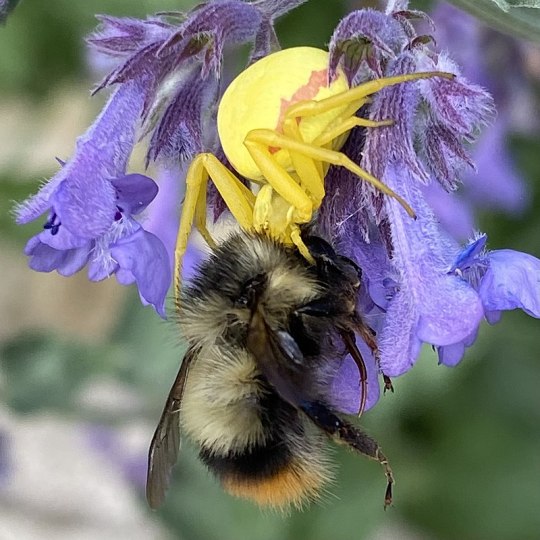
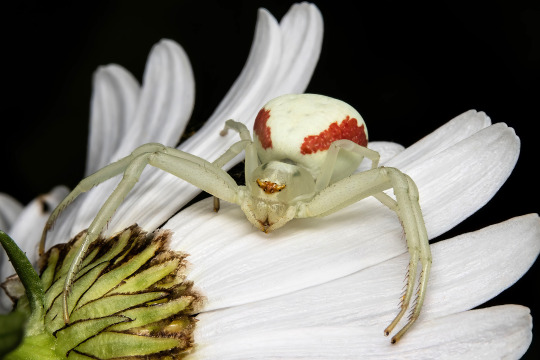
Goldenrod Crab Spider (Misumena vatia)
Distribution: Found in Europe and North America; throughout the USA and southern Canada. Prefers temperate climates.
Habitat: Found in fields or forests; often found on flowering plants such as milkweed, goldenrod, trillium, white fleabane, ox-eye daisy, red clover and buttercup.
Diet: Carnivorous, active predator; feeds on flies, bees, butterflies, grasshoppers, dragonflies and hoverflies. When food is scarce, can also feed on thrips, aphids, dance flies, nectar and pollen.
Description: The goldenrod crab spider takes a more hands-on approach to catching prey than most spiders, forgoing the building of a web in favour of camouflaging itself, usually on a flower, and waiting for prey to fly by before striking. It's able to subdue prey much larger than itself due to its venom; when its prey draws near, it grapples it with its long forelegs, injecting venom and letting it do all the work (another quirk: unlike most spiders, this one doesn't wrap its prey in silk!). Once immobilized, it injects its prey with digestive enzymes and slurps up the resulting insect juice.
Due to its hunting method, the goldenrod crab spider has learned to camouflage itself very effectively by changing its colour, depending on the flowers it sees around it. Usually white, the spider can secrete a yellow liquid into its body's outer cell layer, changing its colour to a yellow of varying intensity. In order to turn white, it can show glands filled with white guanine, which hides the yellow-pigmented cell layer. The goldenrod spider might seem out of place sitting on something like a pink flower, for example, but due to the lack of red light receptors in most arthropods, it's actually camouflaged both to itself and its prey!
(Pictures by Matthew H. Battles and Stephane Boucher)
17 notes
·
View notes
Text
Why are there meadows?
Meadow plants in subalpine areas are better adapted than trees to long winters, deep snows, and a short growing season. At this elevation, slow-growing trees don’t shade out the meadow flowers. Flowers grow most abundantly on south- and west-facing slopes, like at Paradise and Sunrise.
Due to the long winters, subalpine meadow plants have about six weeks to grow, flower, pollinate, and disperse their seeds. Unique adaptations of color, patterns, and fragrances help flowers compete for the attentions of hoverflies, hummingbirds, and other pollinators. Other adaptive strategies equip plants to survive—and even to grow—under the deepest winter snowdrifts.

NPS Photo of a glacier lilies.
Glacier lilies (Erythronium grandiflorum) begin growing under many feet of snow. In spring the plant burns starch to generate heat to melt a hole, then grows up through the hole.

Others like magenta paintbrush (Castilleja parviflora) have hairy stems and flowers to retain warmth and moisture and can grow and bloom quickly as soon as it’s free of snow. The magenta paintbrush pictured in this photo grew and flowered in just a week as soon as the snow melted away from the edge of the plowed road.

NPS Photos of magenta paintbrush along the Sunrise Road, 7/6/22.
Subalpine wildflowers survive on a thin margin and are easily damaged when trampled. Help them survive by always staying on trails!
~kl
#Rainier Science#mount rainier national park#wildflowers#magenta paintbrush#subalpine meadows#Sunrise Road
169 notes
·
View notes
Text
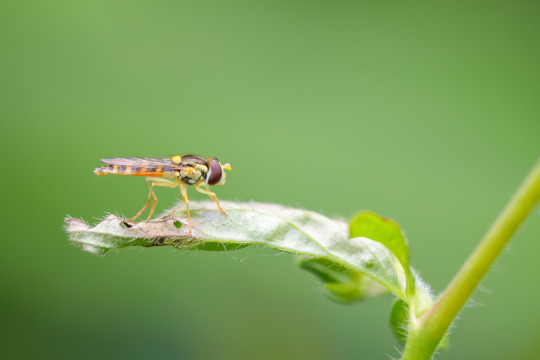
Long Hoverfly
A female long hoverfly sitting on a leaf, in the garden.
#30dayswild#canon#canonuk#Denoise#fauna#garden#hoverflies#hoverfly#insect#insects#invertebrate#invertebrates#long hoverfly#minibeast#minibeasts#nature#outdoors#sphaerophoria scripta#summer#wildlife
2 notes
·
View notes
Text




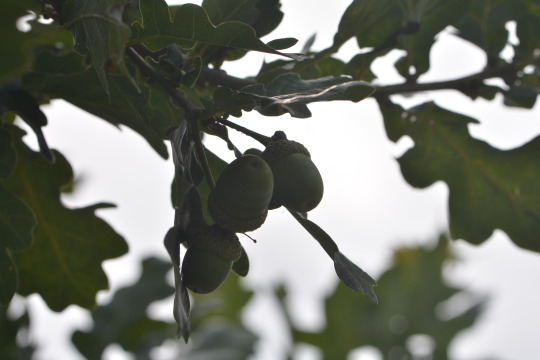
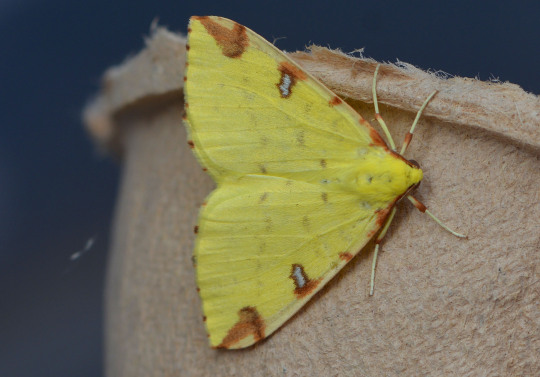

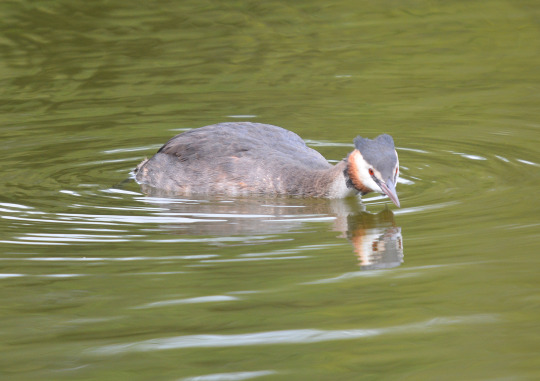


29/08/2023-Lakeside and home
Photos taken in this set: 1. A nice moth that came into a moth trap we did last night. 2. Yarrow out the front. 3. Mugwort on my Lakeside lunch time walk. 4. White-point moth. 5. Acorns on my way to Lakeside, I enjoyed seeing these at Lakeside too on a day I enjoyed oak. 6. A beautiful and dazzling Brimstone moth, we had more than one in the trap a distinctive moth I had enjoyed seeing before this was my first home sighting. I was pleased to see this one. 7. A gorgeous Shuttle-shaped Dart, a fascinating new moth for me. Seeing this alongside a few other new ones and firsts for the year made my moth year list my highest ever, the fourth of my five year lists I've reached this point with this year with the other (my dragonfly and damselfly year list) being my joint highest ever total which I am thrilled with. 8. An adult Great Crested Grebe at Lakeside, I enjoyed great intimate views of it and its calling chick which was a key moment on the walk with others seen. 9. Dogwood, great to see flowering and berries I do enjoy this in the late summer/autumn. 10. View on a lovely lunch time walk.
Other moths seen from the trap were Vine's Rustic again after last night, my first ever Lesser Yellow Underwing and Pale Mottled Willow, Large Yellow Underwing, a stunning Willow Beauty and my first Square-spot Rustics of the year I do love these. A fun activity that we've not done before doing a trap and I think we'll do more. Some fine views of Small White and Speckled Wood were highlights at Lakeside, with Common Darter and a pretty Long Hoverfly seen too. I was fixated on a cheery flock of Long-tailed Tits with Chiffchaff and Great Tit mixed in whilst in the southern fenced off area, with Blue Tit possibly seen too and heard in the garden today. Blackbird, Carrion Crow, Magpie, Woodpigeon, Moorhen adult and young, Mallard and great views of Lesser Black-backed Gull and soothing Wren heard feeling springlike funnily enough as I heard it for a minute were other Lakeside highlights. Cress and dock out the front, giant broad-leaved clovers at Lakeside, knapweed, thistle, ragwort carpeting the place nicely, fleabane, bird's-foot trefoil, lady's bedstraw, my first self-heal for a little while, water mint, great willowherb, purple loosestrife, yarrow, a wealth of rose hips and hawthorn berries were great flowers seen at lunch time. Collared Dove, House Sparrow, Jackdaw, the immersive sight and fluent calls of Starlings and snails on the balcony were good from home sightings today.
#photography#moths#shuttle-shaped dart#the white point#great crested grebe#blackbird#carrion crow#moorhen#common darter#small white#speckled wood#long hoverfly#uk#world#home#lakeside#lakeside country park#nature#2023#europe#birds#birdwatching#photos
1 note
·
View note
Text
@karltface submitted: I appear to have a nursery!

The sheer size of the things (strawberry sized or thereabouts) implies wasps to me, which is wonderful, but apparently it could be anything from fungus to nematodes. Probably not your specialty, but it doesn't hurt to ask. They're attached directly to the leaves, if that helps. Southern WI again.
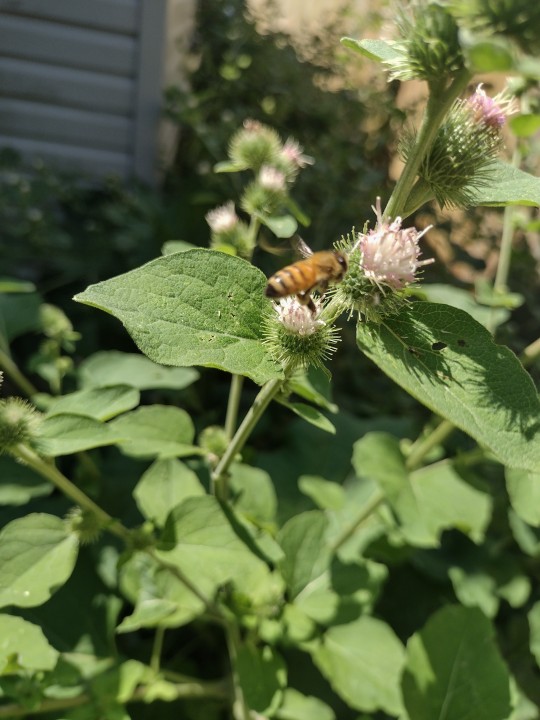
Meanwhile, the burdocks are in bloom, and man are they busy.

Most of the smaller stuff (various hoverflies, long-legged flies) wouldn't hold still for a photo -which is too bad, given how pretty a lot of them are- but here are some fuzzy friends for you. For whatever reason, they're the most popular plants in the yard at the moment.
Yeah I definitely don't know enough about plants and/or galls to ID what's in those. I'd say your best chance is to ID the plant and research from there. Often bugs that make galls are plant-specific. Love the bees, though! Glad they are getting lost in the sauce on y our flowers
40 notes
·
View notes
Note
tell me about bugs ! /lhnp
Aah ty for the ask this is so general there’s so many facts and things um (edit I didn’t mean to write a whole essay you don’t have to read the whole thing)
Recently I’ve been enjoying learning about spiders which is ever so slightly ironic considering how afraid I was of them and how I still am a bit scared to come across ones I’m not familiar with. Learning about them makes them so much less scary though. A lot of the most venomous and scariest spiders are actually relatively docile and won’t bite unless threatened or they’re a mother with babies. In the US there hasn’t been a death from a black widow bite in 40 years bc their bites are rare and able to be treated. A lot of venomous spiders can actually administer dry bites too or control the amount of venom they inject which is super cool. Since their venom is used to kill prey, when they bite a human it’s usually just in self defense so a lot of bites from deadly spiders aren’t actually that dangerous. Ofc it’s still imperative to seek treatment just in case you have a reaction or they did inject venom (although you’d be able to tell there’s some nasty symptoms). Most cases are able to be treated, too, with anti-venom and while not a pleasant experience they’re rarely deadly.
I feel like there needs to be a picture here to break up this post so uhhhhh here’s a bunch of bees on a clover ( and a Yellowjacket)

One of my other interests rn is misconceptions/misidentifications. Which ig ties into spider bites. One common myth is that daddy longlegs spiders are super venomous but their fangs are too small to bite humans. This is very wrong for several reason uhh first is that daddy longlegs is a super broad term used to refer to cellar spiders (actual spiders of the araneae order), harvestmen (arachnids in the opilione order so Not Spiders), and crane flies (these are literally flies as the name suggests. They…. They aren’t spiders they have wings they aren’t venomous. Although they do have long legs). Cellar spiders are a little venomous but their venom poses little harm to humans (just a typical insect bite yk) and they rarely bite humans. Harvestmen actually don’t have venom and don’t have fangs just hollow claws used to grip. Which can’t harm people.
anyway harvestman are the absolute silliest guys I love seeing them bounce around

(Photo credit evanaturalist on inat <3)
Another quickl thing (I promise I’ll stop soon you invoked a topic I’m incapable of being normal about and gave me no limitations or anything so I’m on a ramble there’ll be no survivors etcetc) is also about flies. A lot of people assume those itty bitty sweat bees that hover around you at the park or whatever are actually more likely to be hoverflies (instead of a real sweatbee)! They only have one set of wings (unlike a bee) and no they can’t sting. I told this all to my friend at a concert who was being very annoyed by the one following her around and after explaining them and marveling over the super cool patterning of the calligrapher flies (specific type of hoverfly) they actually came around and admitted they’re very cool and it was a lovely moment bc once you know more about something then you can accept it more yay woohoo.

^ the black and yellow is deceiving it only has the one set of wings. If you cared the one pictured is a maize calligrapher specifically . Very common in the US and Canada.
Oh and I got a millipede tatto did you see :]
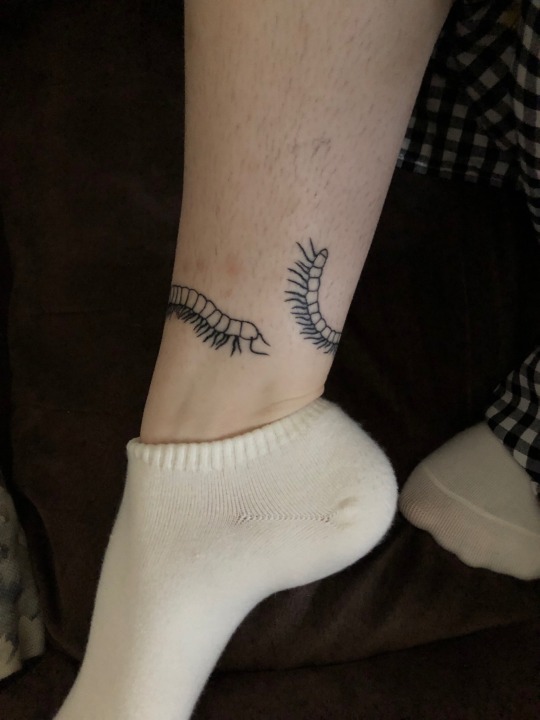
#thank you for coming to my Tedtalk I apologise for it being ten trillion years long#and I’m sorry idk when to make paragraph breaks so it’s very long chunks of text#I just think talking about bugs and creepy crawlies#and generally expressing my admiration for them#helps break down people’s immediate fears and judgement of them and it’s super fun and cool to watch#hopefully you don’t mind learning about spiders I used to hateeee them#I tried to mix it up a bit too#I hope you didn’t expect just a couple of fun facts I don’t really have those#just lectures I could teach a class#one fact is that spring flies have these tails or whatever#that rest under their body and they use them to spring into the air#which is cool#sorry sorry for the ramble#you said ‘no pressure ☺️’ and I said just went off#kestrel calls#chitter chatter#ty for the ask thoigh <3#mutuals <3#desc in alt#bugs#spiders#this is like a unskippable cutscene except you can skip it
13 notes
·
View notes
Note
BEEEEEEEEEEEEEEEEEEEEEEEEEEEEEEEEE

Bees are winged insects closely related to wasps and ants, known for their roles in pollination and, in the case of the best-known bee species, the western honey bee, for producing honey. Bees are a monophyleticlineage within the superfamily Apoidea. They are currently considered a clade, called Anthophila.[1] There are over 20,000 known species of bees in seven recognized biological families.[2][3][4] Some species – including honey bees, bumblebees, and stingless bees – live socially in colonies while most species (>90%) – including mason bees, carpenter bees, leafcutter bees, and sweat bees – are
solitary.
Bees are found on every continent except Antarctica, in every habitat on the planet that contains insect-pollinated flowering plants. The most common bees in the Northern Hemisphere are the Halictidae, or sweat bees, but they are small and often mistaken for wasps or flies. Bees range in size from tiny stingless bee species, whose workers are less than 2 millimetres (0.08 in) long,[5] to Megachile pluto, the largest species of leafcutter bee, whose females can attain a length of 39 millimetres (1.54 in).
Bees feed on nectar and pollen, the former primarily as an energy source and the latter primarily for proteinand other nutrients. Most pollen is used as food for their larvae. Vertebrate predators of bees include primates and birds such as bee-eaters; insect predators include beewolves and dragonflies.
Bee pollination is important both ecologically and commercially, and the decline in wild bees has increased the value of pollination by commercially managed hives of honey bees. The analysis of 353 wild bee and hoverfly species across Britain from 1980 to 2013 found the insects have been lost from a quarter of the places they inhabited in 1980.[6]
Human beekeeping or apiculture (meliponiculture for stingless bees) has been practised for millennia, since at least the times of Ancient Egypt and Ancient Greece. Bees have appeared in mythology and folklore, through all phases of art and literature from ancient times to the present day, although primarily focused in the Northern Hemisphere where beekeeping is far more common. In Mesoamerica, the Mayans have practiced large-scale intensive meliponiculture since pre-Columbian times.[5]
Get Wikipedia articled.
2 notes
·
View notes
Text
A flying hoverfly.
I have been trying for so long and finally got it.

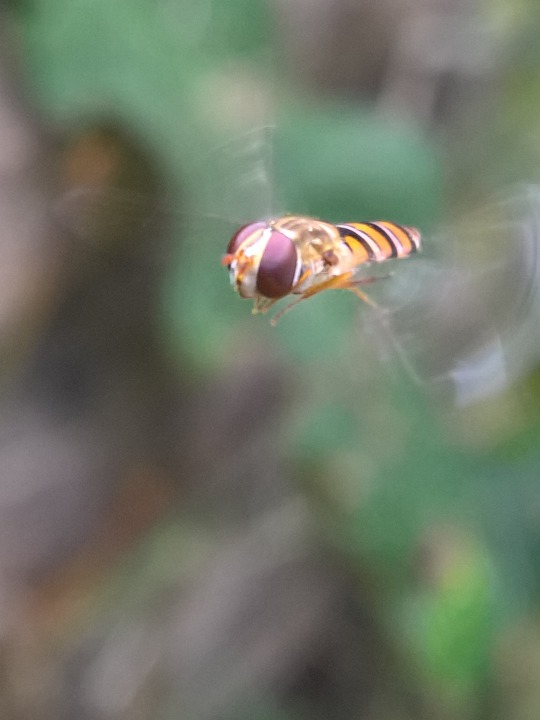
129 notes
·
View notes